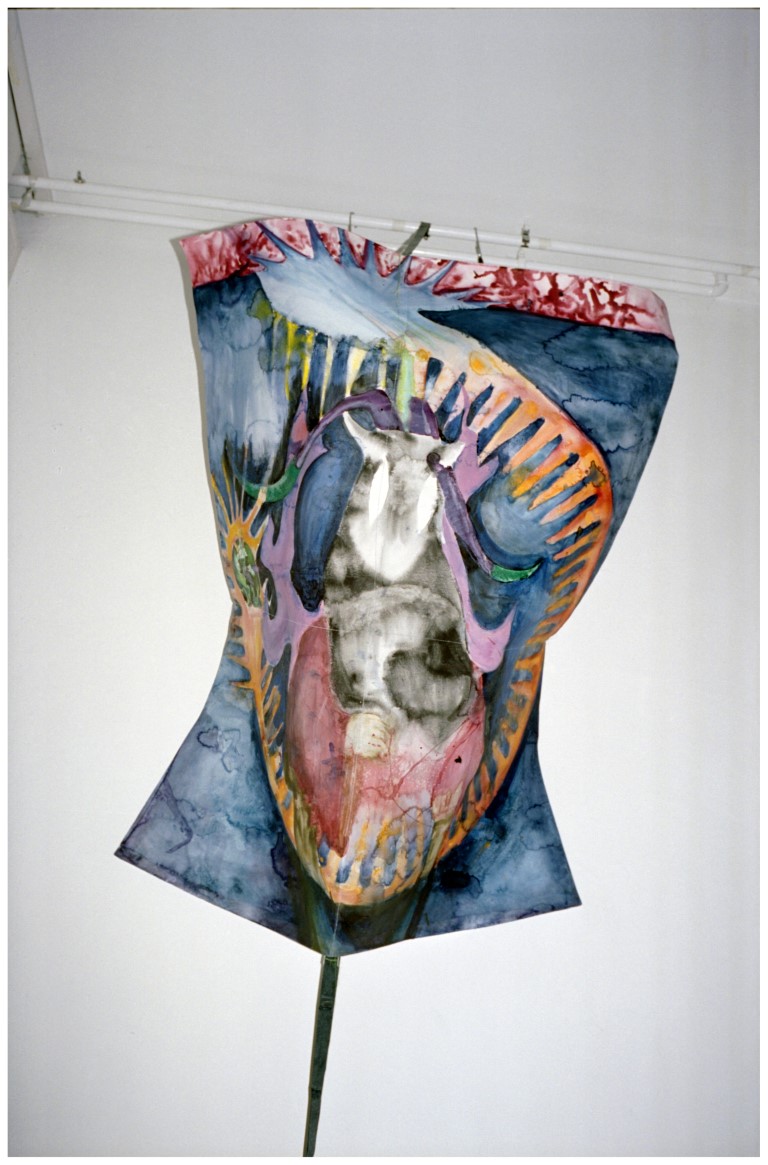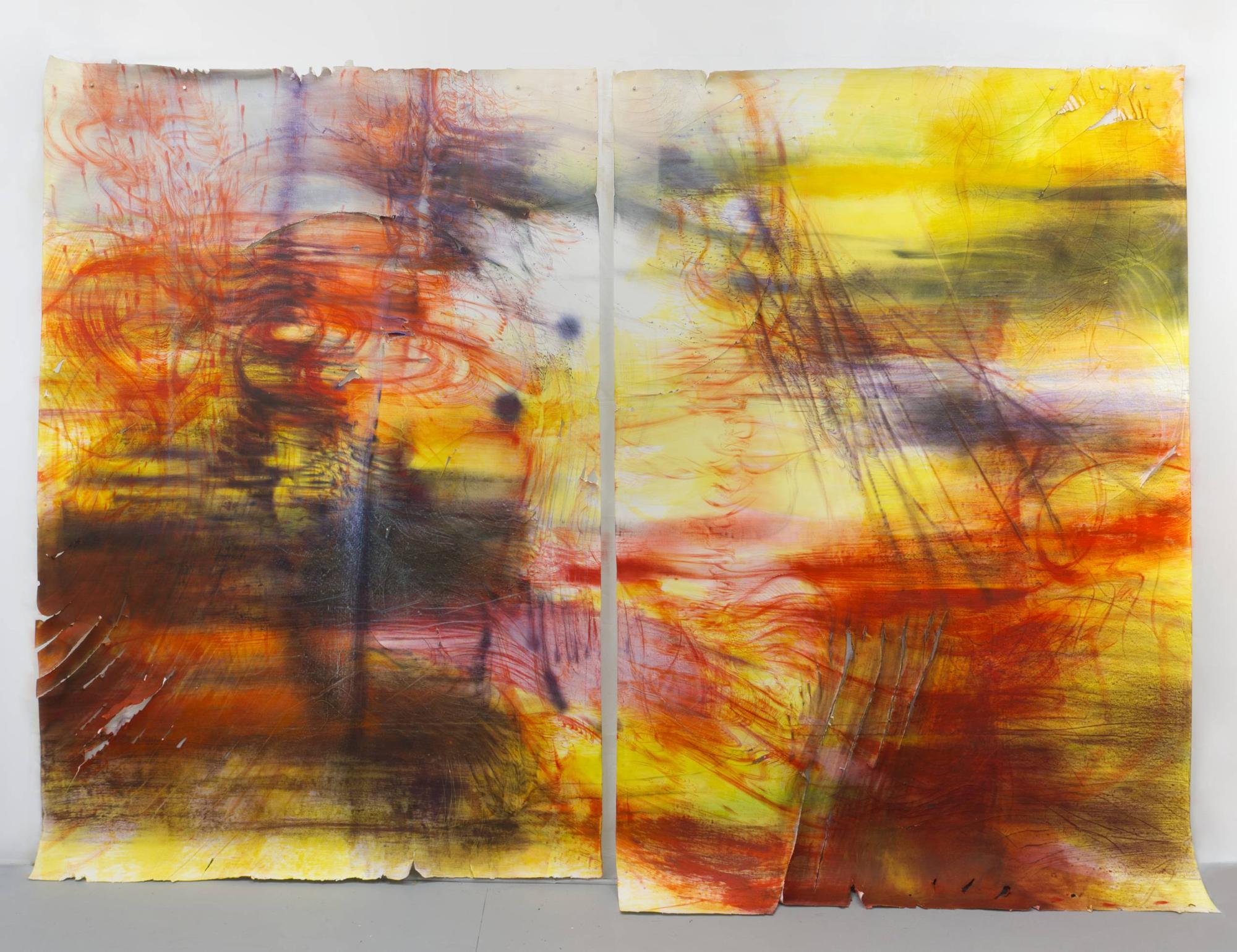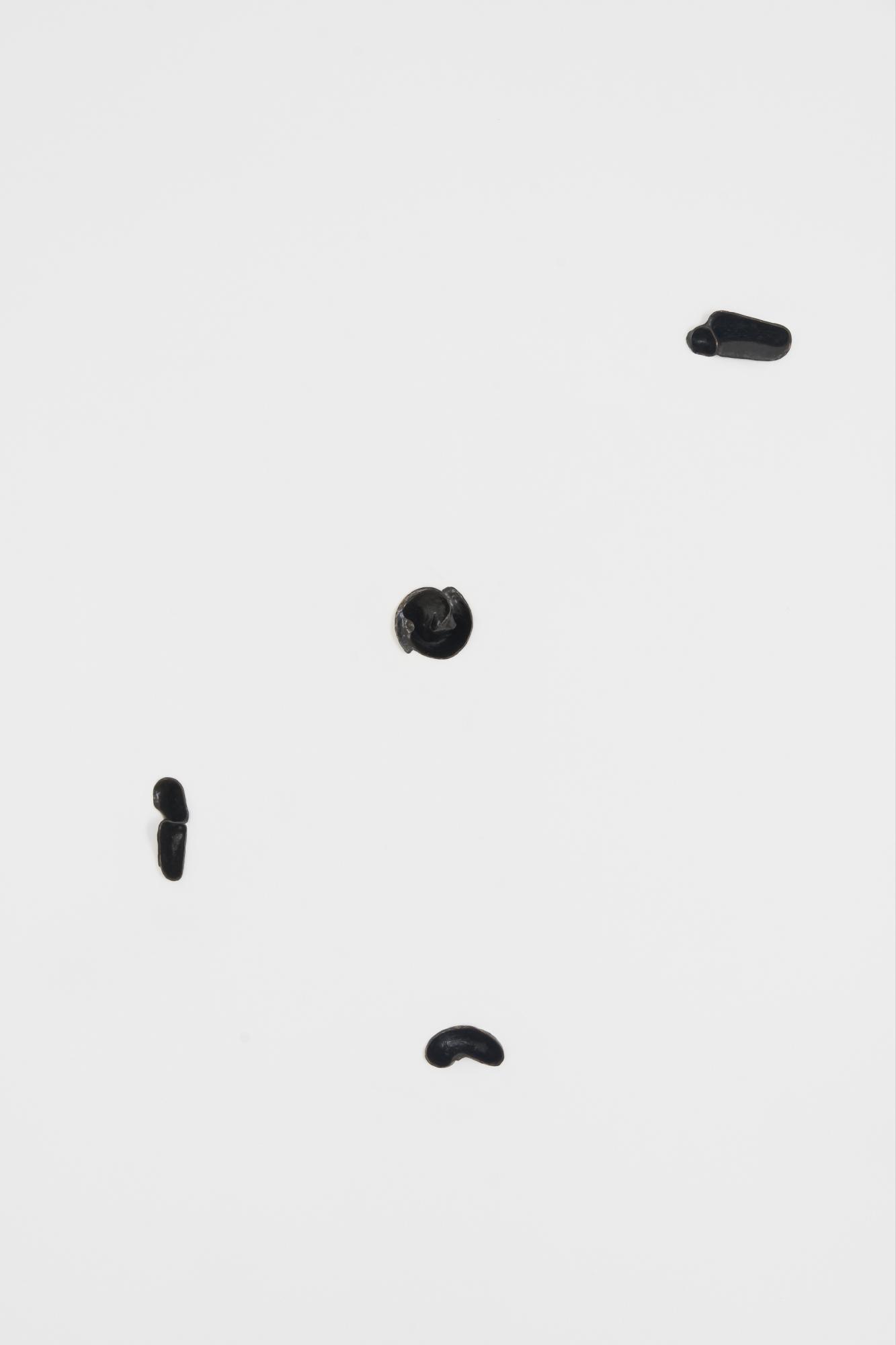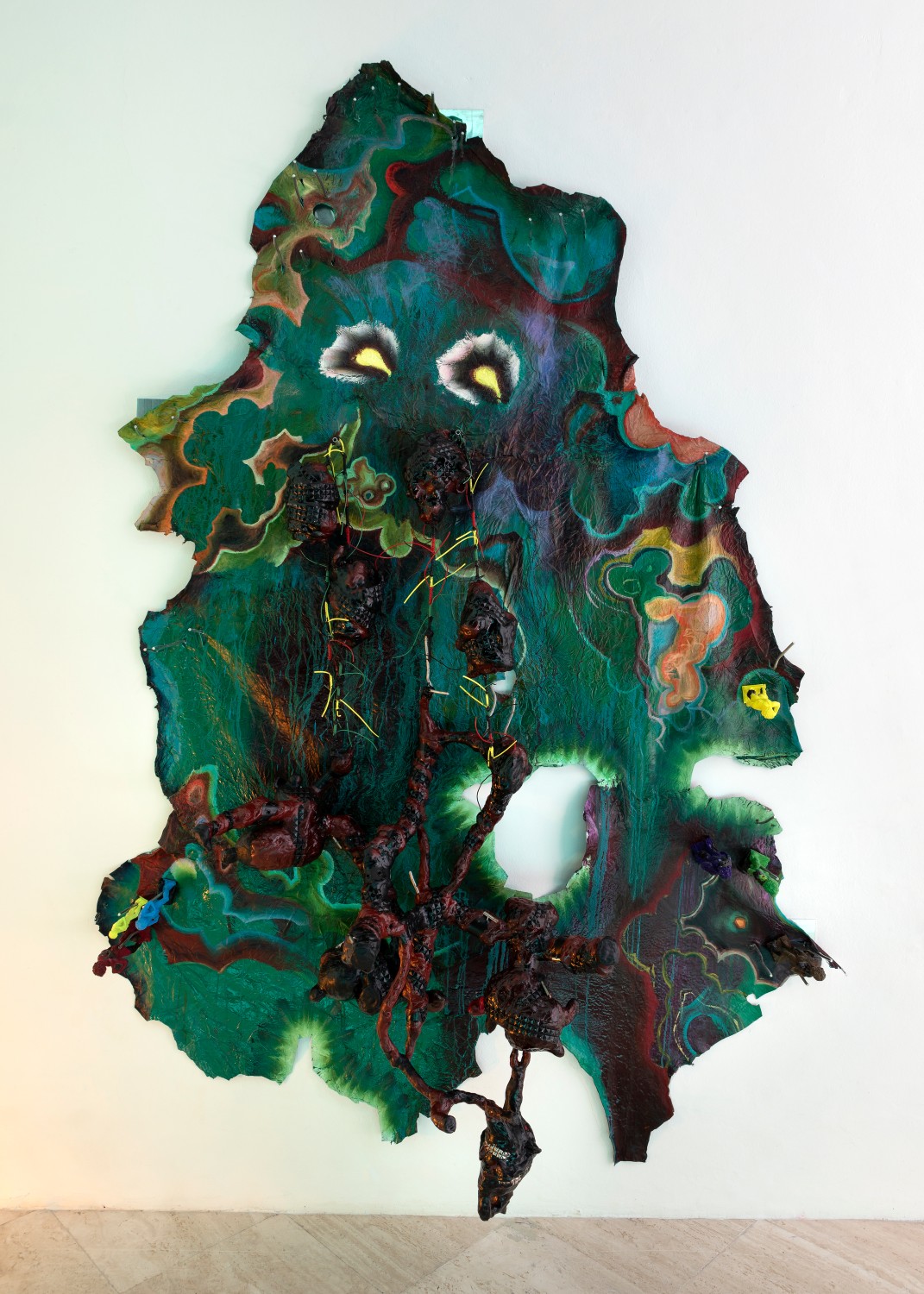
 Zurück
Zurück
Galerie Elisabeth & Klaus Thoman
curated by Monika Bayer-Wermuth


Dr. Monika Bayer-Wermuth ist leitende Kuratorin am Museum Brandhorst in München, wo sie die Sammlung sowie internationale Ausstellungs- und Publikationsprojekte verantwortet. Im Mittelpunkt ihrer kuratorischen Arbeit steht die tiefgehende Auseinandersetzung mit künstlerischer Produktion sowie gesellschaftliche und politische Fragestellungen der Gegenwartskunst, die sie zugänglich und kritisch in den institutionellen Kontext zu übersetzen versucht. Zu ihren Ausstellungen zählen unter anderem „Alexandra Bircken. A–Z“, „Nicole Eisenman. What Happened“ und zuletzt „This Is Me, This Is You. Die Eva Felten Fotosammlung“. Derzeit arbeitet sie an einer großen Neupräsentation der Sammlung. Vor dem Museum Brandhorst war sie an der Tate Modern in London (2016–2019) sowie am Lenbachhaus in München (2014–2016) tätig. Ihre Dissertation „Harun Farocki: Arbeit“ erschien 2017 im Verlag Silke Schreiber. Sie gehört dem Beirat des Kunstraums München an.


KAYA überschreiten in kollaborativer Praxis die Grenzen zwischen Malerei und Skulptur und verschmelzen beide Gattungen zu einem neuen, hybriden künstlerischen Ansatz. Ihre Arbeiten fungieren als Gefäße einer Art Intersubjektivität, die zugleich die individuellen Handschriften der Künstlerinnen bewahrt und sublimiert. Auch folgen sie einer geologischen Logik, einer organischen Entstehungsgeschichte: Ehemalige KAYA-Performance-Objekte und Ephemera werden bewahrt, zerkleinert, umgearbeitet und in neue Werke überführt. So entstehen aus dem Material des Vergangenen fortwährend neue, sich stets weiterentwickelnde Körper. In jüngerer Zeit hat sich KAYA zu einer kollaborativen Plattform entwickelt, die über das künstlerische Werk von „Brätsch und Eilers“ hinaus die kreativen Energien jener Gemeinschaft einbezieht, die sich in jeder Projektiteration um KAYA bildet. Dazu zählen häufig andere Künstler*innen ebenso wie Studierende, Kurator*innen, Wissenschaftler*innen und die Institution, die jeweils Gastgeberin des Projekts ist.
KAYA agiert als fiktiver und zugleich konkreter Körper und verbindet formale, malerische und metabolische Verfahren in der Produktion von Identität. KAYA ist ein gemeinschaftliches Projekt, das 2010 von der Malerin Kerstin Brätsch (*1979, Hamburg) und dem Bildhauer Debo Eilers (*1974, Texas, USA) gegründet wurde. Beide leben und arbeiten in New York City und Berlin. Zu den jüngsten Einzel- und Gruppenausstellungen zählen Marta Herford (2024); Museum Brandhorst, München (2023); Antenna Space, Shanghai, China (2023); Haus der Kunst, München (2018); Whitney Biennale, New York, USA (2017); Mumok, Wien (2016); KUB Kunsthaus Bregenz (2015); MWoods, Peking (2015); 47 Canal, New York, USA (2013); Fridericianum, Kassel (2013).


Die Malerei steht im Zentrum der künstlerischen Praxis von Maria VMier. Sie entwickelt sich aus gestischen Schreibbewegungen, aus einer feinen, eigenwilligen Zeichensetzung hin zu komplexen Formationen, die sich in einem Zustand ständiger Bewegung zu befinden scheinen. Für MVM ist Malerei weniger ein Ort der Verfestigung oder des Ausdrucks, sondern vielmehr eine Praxis der Forschung, der Erfahrung und des (Ver-)Lernens.
Maria VMiers interdisziplinäre Arbeit umfasst kontextspezifische und gemeinschaftsbildende Projekte ebenso wie Installationen, Künstler*innenbücher und Objekte. Im Mittelpunkt steht dabei der Körper als Werkzeug der Erkenntnis, als Schauplatz politischer Auseinandersetzung und Quelle von Freude. Wiederkehrende Themen sind die Bedingungen künstlerischer Arbeit, Macht- und Begehrensverhältnisse, Institutionen als formbare Strukturen, Natur, das Unsichtbare und das Unbekannte.
Maria VMier (geb. 1985 in Passau) studierte Malerei und Bildhauerei am Bard College, an der Akademie der Bildenden Künste München sowie an der Universität für angewandte Kunst Wien. Ihre Arbeiten wurden 2024 unter anderem im MoMA PS1, im Museum Brandhorst und in der Pinakothek der Moderne gezeigt. Ihre Praxis ist stark in kollektiven und gemeinschaftlichen Prozessen verankert: Regelmäßig lädt sie weitere Künstler*innen in ihre Projekte ein, betreibt gemeinsam mit Stefanie Hammann den Künstler*innenbuchverlag Hammann von Mier Verlag und ist Teil des Kollektivs Ruine München zusammen mit Leo Heinik und Jan Erbelding.


Ari Pilhofer (geb. 1993 in Amberg, Bayern) ist interdisziplinäre Künstler:in mit Sitz in London und in den Bereichen Malerei, Skulptur, Performance, Sound, Keramik, digitales Modellieren und Text aktiv.
Pillhofers Praxis erweitert die Malerei zu einem durchlässigen System, das in Skulpturen, Gesten, Installationen, Klang und Performance übergeht.
Deren Arbeiten untersuchen, wie Identität und ästhetisches Urteil gesellschaftlich und klassenkulturell konstruiert werden.
Inspiriert von Queer-Theorie, bayerischer Folklore, deutschen Subkulturen und persönlicher Mythologie entstehen fragmentarische Formen, die sich einer Auflösung entziehen.
Eine wiederkehrende Figur namens „Spider-Knight“ fungiert als geschlechtsverweigernde Archetype und erscheint in Performances, Skulpturen und Bildern als wandelbares Gefäß von Schutz und Widerstand.
Pilhofers Prozesse verbinden analoge und digitale Werkzeuge: bemalte Oberflächen werden gescannt, verzerrt und als Keramiken, skulpturale Objekte oder Kleidungsstücke re-materialisiert. Auf diese Weise wird eine Art Techno-Magie aktiviert, die Symbole in Texturen, Bilder in Körper und digitale Geister in greifbare Artefakte verwandelt.
Sanftheit, Wiederholung und handwerkliche Techniken – wie Nähen, Gießen und Schichten – werden nicht als ästhetische Dekoration, sondern als politische Gesten eingesetzt.
Zudem eignet sich Pilhofer okkultes, intuitives und sogenannt „irrationales“ Wissen (Wahrsagung, Mystik, textile Sprache) als ernsthafte Form verkörperter Forschung und Widerstandsstrategien an.
Pilhofers Arbeiten wurden im In- und Ausland gezeigt u.a.: Galvani Galerie (Nürnberg, DE), Kurt-Kurt (Berlin, DE), Bayerisches Staatsministerium (München, DE), Warehouse X1 (Boston, Massachusetts, USA) sowie in kollaborativen Performances mit der Künstlerin Simone Körner in Nürnberg und Chicago, Illinois (USA).
Pilhofer leitete Workshops an der Internationalen Sommerakademie in Salzburg und an der HFBK Hamburg – in Zusammenarbeit mit der Künstlerin Andrea Huyoff.
Pilhofer ist Teil der SOMA Summer Residency 2025 in Mexiko-Stadt und absolviert derzeit ein Masterstudium in Malerei an der Slade School of Fine Art in London, gefördert durch ein DAAD-Stipendium (2024–2026)

And When I See a Ghost I Really See a Ghost
Kaum ein anderes Medium der Kunstgeschichte war derart verhaftet in der Vorstellung individueller Autor:innenschaft wie die Malerei. Sie gilt als paradigmatische Form schöpferischer Subjektivität – ein Medium, das in direkter physischer Verbindung zur Produzent:in steht: der Pinselstrich als Signatur des Körpers, die Oberfläche als psychologischer Resonanzraum. Diese Verbindung von Handlung, Materialität und Autor:innenschaft ist konstitutiv für die westliche Idee des künstlerischen Genies.
Die Ausstellung And When I See a Ghost I Really See a Ghost problematisiert und dezentriert diese Vorstellung. In den gezeigten Positionen wird Malerei nicht als abgeschlossenes Objekt, sondern als relationales Feld verstanden – als prozesshafte Formation, in der Subjektivität, Materialität und Raum instabil und durchlässig werden. An die Stelle einer einheitlichen Autor:innenschaft tritt eine fragmentierte, geteilte, mitunter unbestimmbare Struktur künstlerischer Produktion. Das Werk wird nicht länger als Manifestation eines autonomen Subjekts begriffen, sondern als Schnittstelle zwischen ökonomischen, ethischen, sozialen und ästhetischen Parametern.
Der Begriff der „Position“ fungiert dabei bewusst als Gegenmodell zur Vorstellung eines kohärenten Künstler:innen-Subjekts. Er markiert eine Haltung innerhalb eines diskursiven Feldes, ohne sie biografisch oder stilistisch zu essentialisieren. Die beteiligten Praktiken operieren mit einer erweiterten Form von Malerei, die nicht nur die Grenze der Leinwand überschreitet, sondern auch institutionelle und mediale Konventionen unterläuft. Die Bildfläche wird selbst zum Subjekt, das sich in den Ausstellungsraum ausdehnt, das Werk zum Knotenpunkt geteilter Subjektivitäten.
Diese Strategien verhandeln nicht nur Fragen ästhetischer Form, sondern adressieren grundlegend den Status des Kunstwerks in einer Gegenwart, in der Produktion und Rezeption nicht mehr getrennt, sondern als zirkuläre Bewegungen verstanden werden müssen. Malerei erscheint hier nicht als autonome Sprache, sondern als fluide Struktur, innerhalb derer sich Autor:innenschaft, Materialität und Bedeutung permanent neu konfigurieren.
Bei KAYA – einem seit 2010 bestehenden kollaborativen Projekt von Kerstin Brätsch und Debo Eilers sowie bisweilen der namensgebenden Kaya Serene – wird Malerei als instabiles, transmediales Gefüge verhandelt. Die Konstellation verweigert sich der Idee kohärenter Künstler:innenidentität und entwickelt stattdessen ein „Anti-Ich“, in dem künstlerische Autor:innenschaft nicht repräsentiert, sondern als prozesshafte, fluide Instanz organisiert ist. KAYA operiert nicht aus einem Subjekt heraus, sondern als situative Formation, in der Malerei, Körper und Objekt in ein instabiles Verhältnis treten, in dem das Objekt selbst Subjektstatus erhält und mit Erfahrungen, sozialen Begegnungen, aber auch Gewalt aufgeladen wird. In der Arbeit SPREPPER_SCHNAKEN Table #1 (2015) etwa – ein seziertischartiges Display mit Körperabgüssen von Kaya und einer mit Spanngurten fixierten Malerei auf Polyesterfolie – tritt die bildliche Geste in ein Spannungsverhältnis zur materiellen Präsenz des Körpers. Die Verschnallung des Bildes wie des Körpers, die sichtbare Markierung mit Münzen, verweisen auf eine radikale Sichtbarmachung von Kapitalisierungsprozessen: Malerei fungiert hier nicht als Ort subjektiver Selbstentäußerung, sondern als Vehikel ökonomischer Einschreibung – ebenso der Körper, der sich als Träger von Wertzuschreibungen und als Teil zirkulierender Märkte erweist. Malerei wird zur durchlässigen Membran zwischen Objekt, Subjekt und System.
Auch bei Maria MVier ist Malerei keine abgeschlossene Bildform, sondern eine relationale Formation – ein Komplex aus Geste, Fläche, Textur und Körper. Ihre auf gefaltetem Papier ausgeführten Arbeiten destabilisieren die klassische Vorstellung des Bildes als kohärenter Fläche. Stattdessen fragmentiert sie Raum und Bildträger in Einheiten der Aufmerksamkeit, wodurch sich ein zentrierter, autoritärer Blick ebenso auflöst wie die Vorstellung eines singulären künstlerischen Ausdrucks. Ihre Praxis artikuliert sich als „Companion-System“ – eine nicht-hierarchische Verschränkung von Bildträger und Raum, von Produzent:in(nen) und Betrachter:in(nen). In ihrer Arbeit Das Ende des Kapitalismus [mit LJ Jeschke] reflektiert VMier die eigene Rolle als Produzent:in im Spannungsfeld zwischen künstlerischer Aneignung und ökonomischer Rückbindung: Anstatt auf das titelgebende Zitat aus Lisa Jeschkes Text Alien / Care / Wall nur mit einer sprachlichen Referenz zu reagieren, sieht VMier eine Form der Teilhabe vor. So stellt sich ihre Malerei nicht nur formal gegen die Produktlogik kapitalistischer Bildproduktion, sondern unterläuft auch deren Verwertungslogik – durch Prozesse der Rückgabe, Kooperation und situativer Präsenz. Die Geste wird nicht gelöscht, sondern wird identitärer Teil des Werkes selbst.
Ari Pilhofer entwickelt ein erweitertes Verständnis von Malerei als instabiles System, das sich über Malgrund, Körper, Skulptur und digitale Medien hinweg artikuliert. Ihre Arbeiten operieren mit queer codierten, hybriden Figuren – Masken, Gliedmaßen, Insektenkörpern, rituell aufgeladenen Schattenwesen – die sich eindeutiger Repräsentation entziehen. Statt ein kohärentes Bild zu entwerfen, produziert Pilhofer Übergänge, Unschärfen, Durchlässigkeiten. Die Malereien, oft schwebend installiert, erscheinen als Körper – verletzlich, weich, multipel – und zugleich als Träger techno-symbolischer Transformation. Analoge und digitale Verfahren verschränken sich: Gemalte Oberflächen werden gescannt, bearbeitet und in Skulptur, Keramik oder Kleidung überführt. Diese Prozesse erzeugen eine Form techno-magischer Bildlichkeit, in der Symbole, Oberflächen und Körper ineinander übergehen. Pilhofer begreift Weichheit, Wiederholung und Handwerk – etwa durch Nähen, Gießen, Schichten – nicht als ornamentale Geste, sondern als politische Strategie der Resistenz und Umcodierung. Der wiederkehrende Archetyp der „Spider-Knight“ fungiert dabei als fluides Gefäß kollektiver Schutz- und Verweigerungspraktiken. Pilhofers Arbeiten unterlaufen kategoriale Trennungen zwischen Subjekt und Objekt, Materialität und Immaterialität, und generieren eine Bildpraxis der Re-Ritualisierung, in der sich digitale und immaterielle Gespenster zu greifbaren Artefakten formieren.
Der Ausstellungstitel geht auf die kollaborative Arbeit Kollega (1993) von Franz West und Herbert Brandl zurück. Auf den Sockel der Skulptur schrieben sie den Satz: „Wenn ich einen Geist sehe, sehe ich wirklich einen Geist“ – ein Ausspruch, der dem Physiker und Wissenschaftstheoretiker Ernst Mach zugeschrieben wird. West war bekannt dafür, sich theoretische Diskurse aneignend einzuverleiben, wobei er weniger an systematischer Exegese interessiert war, als an deren subversiv-assoziativer Umnutzung. Der Satz selbst erscheint emblematisch für eine Infragestellung stabiler Identitätskonzepte: Er verhandelt Sichtbarkeit, Projektion, Materialität und das Phantomhafte des Wahrgenommenen. Im Kontext der Ausstellung dient er als Bezugspunkt für eine Untersuchung von Malerei als prozesshafte, relationale und durch Subjektivitätsverschiebungen geprägte Praxis.
Ernst Mach, der als Physiker, aber auch als Wegbereiter der Wissenschafts-philosophie bekannt wurde, fungiert dabei – insbesondere mit seiner These von der Illusion des Ichs – als theoretischer Resonanzraum. In Machs Denken ist das Ich keine ontologisch gesicherte Instanz, sondern ein fluktuierendes Aggregat aus Sinneseindrücken, Erinnerungen und Relationen. Geist und Materie sind in diesem Modell keine dichotomen Größen, sondern Momente eines kontinuierlichen Erfahrungsstroms. Genau in dieser Destabilisierung des Subjekts liegt das kritische Potential, das die Ausstellung aufgreift: Malerei wird hier nicht als Ausdruck individueller Tiefe verhandelt, sondern als Ort von Fragmentierung, Medialität und Verhandlung von Autor:innenschaft.

Media
Bilder
Ari Pilhofer, BAPHOMET, 2025, aquarelle and acrylic on paper, tension belt, glazed ceramic element, 150 x 120 cm, unique
Photo © Lukas Ulrich
Maria VMier, Das Ende des Kapitalismus, 2024
Ink, pigment, acrylic, oil pastel, charcoal on perforated paper (2 panels), 270 x 365 cm
Courtesy the artist and Deborah Schamoni
Maria VMier, Koordinaten, 2025
Bronze (four parts), 105 x 100 x 10 cm
Photo © Dirk Tacke
Courtesy the artist and Deborah Schamoni




